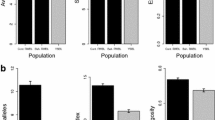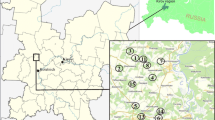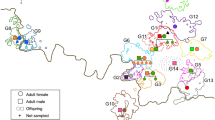Summary
Previous studies have shown that extra-pair paternity occurs less frequently in island populations than in mainland populations. This is thought to be due mainly to the low genetic variability in island populations but non-genetic factors have also been discussed. Here we report the results of a parentage analysis in a population of island canaries (Serinus canaria) on a small uninhabited island in the Madeiran archipelago. Island canaries are socially monogamous, non-migratory seasonal breeders where biparental care is essential for offspring survival. Multilocus DNA-fingerprinting provided no evidence of extra-pair-paternity in 15 families comprising 45 juveniles. The band sharing coefficient for presumably unrelated breeding pairs was low (0.17 ± 0.03), an indication that genetic variability within the population is similar to most non-island populations of other species. Females did not seek extra-pair copulations and actively rejected sexual approaches from males other than their mate. We propose that female island canaries assess the quality of males during a perid outside the breeding season and optimise their mate choice according to learned preferences.
Zusammenfassung
Vorangegangene Untersuchungen haben gezeigt, dass Vaterschaften außerhalb des Paarbundes bei Inselpopulationen weniger häufig vorkommen als bei Festlandpopulationen. Dieses Phänomen wird hauptsächlich mit der bei Inselpopulationen auftretenden geringeren genetischen Variabilität begründet, aber auch nicht-genetische Faktoren werden diskutiert. Wir stellen in der vorliegenden Studie die Ergebnisse einer Vaterschaftsanalyse in einer Kanarengirlitz-Population auf einer kleinen, unbewohnten Insel im Madeira-Archipel vor. Kanarengirlitze sind sozial monogame Standvögel, die saisonal brüten. Die Brutpflege beider Eltern ist entscheidend für das überleben der Jungvögel. Multilocus-DNA-Fingerprinting ergab keinen Fall von Vaterschaften außerhalb des Paarbundes in 15 untersuchten Familien mit insgesamt 45 Jungvögeln. Der Anteil gemeinsamer Banden zwischen den unverwandten Elterntieren war niedrig (0.17 ± 0.03, Mittelwert ± s. d.), was darauf hindeutet, dass die genetische Variabilität dieser Population ähnlich der von Festlandpopulationen anderer Arten ist. Es konnte kein Fall beobachtet werden, in dem Weibchen Kopulationen mit fremden Männchen zu erlangen versuchten. Vielmehr verweigerten sie aktiv Kopulationsversuche fremder Männchen. Wir schlagen vor, dass die Kanarengirlitz-Weibchen die Zeit außerhalb der Brutzeit nutzen, um die Qualität der Männchen festzustellen und anhand gelernter Präferenzen ihre Partnerwahl optimieren.
Similar content being viewed by others
References
Beguin, N., Leboucher, G. & Kreutzer, M. (1998): Sexual preferences for mate song in female canaries (Serinus canaria). Behaviour 135: 1185–1196.
Birkhead, T. R. & Møller, A. P (1996): Monogamy and sperm competition in birds. In: Black, J. M. (Ed.): Partnerships in birds: The study of Monogamy, pp. 323–343. Oxford.
Birkhead, T. R., Burke, T., Zann, R., Hunter, F. M. & Krupa, A. P. (1990): Extra-pair paternity and intraspecific brood parasitism in wild zebra finchesTaeniopygia guttata, revealed by DNA fingerprinting. Behav. Ecol. Sociobiol. 27: 315–324.
Burke, T. & Bruford, M. W. (1987): DNA fingerprinting in birds. Nature 327: 149–152.
Burke, T., Davies, N. B., Bruford, M. W. & Hatchwell, B. J. (1989): Parental care and mating behavior of polyandrous dunnocks Prunella modularis related to paternity by DNA fingerprinting. Nature 338: 249–251.
Cate, C. ten & Vos, D. R. (1999): Sexual imprinting and evolutionary processes in birds: a reassessment. Adv. Stud. Behav. 28: 1–31.
Depraz, V., Leboucher, G. & Kreutzer, M. (2000): Early tutoring and adult reproductive behaviour in female domestic canary (Serinus canaria). Anim. Cogn 3: 45–51.
Epplen, J. T. (1992): The methodology of multilocus DNA fingerprinting using radioactive or nonradioactive oligonucleotide probes specific for simple repeat motifs. In: Chrambach, A., Dunn, M. J. & Radola, B. J. (eds.) Advances in electrophoresis, Vol. 5: 59–112. Weinheim.
Gilbert, L., Burke, T. & Krupa, A. (1998): No evidence for extra-paternity in the western gull. Mol. Ecol. 7: 1549–1552.
Gowaty, P. A. (1996a): Field studies of parental care in birds. In: Rosenblatt, J. S. & Snowdon, C. T. (Eds.): Advances in the study of behaviour, Vol. 25: 477–531. San Diego.
Gowaty, P. A. (1996b): Battles of the sexes and origins of monogamy. In: Black, J. M. (Ed.): Partnerships in birds: The study of Monogamy, pp. 21–52. Oxford.
Griffith, S. C. (2000): High fidelity on islands: a comparative study of extrapair paternity in passerine birds. Behav. Ecol. 11: 265–273.
Griffith, S. C., Stewart, I. R. K., Dawson, D. A., Owens, I. P. F. & Burke, T. (1999): Contrasting levels of extra-pair paternity in mainland and island populations of the house sparrow (Passer domesticus): is there an ‘island effect’? Biol. J. Linn. Soc. 68: 303–316.
Gyllensten, U. B., Jakobsson, S. & Temrin, H. (1990): No evidence for illegitimate young in monogamous and polygynous warblers. Nature 343: 168–170.
Haggerty, T. M., Morton, E. S. & Fleischer, R. C. (2001): Genetic monogamy in Carolina wrens (Thryothorus ludovicianus). Auk 118: 215–219.
Hunter, F. M., Burke, T. & Watts, S. E. (1992): Frequent copulations as a method of paternity assurance in the Northern fulmar. Anim. Behav. 44: 149–156.
Jeffreys, A. J., Wilson, V. and Thein, S. L. (1985): Hypervariable ‘minisatellite’ regions in human DNA. Nature 357: 494–496.
Kempenaers, B. (1993): The use of a breeding synchrony index. Ornis Scand. 24: 84.
Lack, D. (1968): Ecological adaptations for breeding in birds. London.
Leitner, S., Voigt, C. & Gahr, M. (2001): Seasonal changes in the song pattern of the non-domesticated island canary (Serinus canaria), a field study. Behaviour 138: 885–904.
Mauck, R. A., Waite, T. A. & Parker, P. G. (1995): Monogamy in Leach’s Storm-Petrel. DNA fingerprinting evidence. Auk 112: 473–482.
Müller, W., Epplen, J. T. & Lubjuhn, T. (2001): Genetic paternity analyses in Little Owls (Athene noctua): does the high rate of paternal care select against extra-pair young? J. Ornithol. 142: 195–203.
Mulder, R. A., Dunn, P. O., Cockburn, A., Lazenby-Cohen, K. A. & Howell, M. J. (1994): Helpers liberate female fairy-wrens from constraints on extra-pair mate choice. Proc. R. Soc. Lond. B 255: 223–229.
Nagle, L. & Kreutzer, M. (1997): Song tutoring influences female song preferences in domesticated canaries. Behaviour 134: 89–104.
Petrie, M., Doums, C. & Moller, A. P. (1998): The degree of extra-pair paternity increases with genetic variability. Proc. Natl. Acad. Sci. USA 95: 9390–9395.
Petrie, M. & Kempenaers, B. (1998): Extra-pair paternity in birds: explaining variation between species and populations. Trends Ecol. Evol. 13: 52–58.
Pinxten, R., Hanotte, O., Eens, M., Verheyen, R. F., Dhondt, A. A. & Burke, T. (1993): Extra-pair paternity and intraspecific brood parasitism in the European starling,Sturnus vulgaris: evidence from DNA fingerprinting. Anim. Behav. 45: 795–809.
Quillfeldt, P., Schmoll, T., Peter, H. U., Epplen, J. T. & Lubjuhn T., (2001): Genetic monogamy in Wilson’s storm-petrel. Auk 118: 242–248.
Sambrook, J., Fritsch, E. E & Maniatis, T. (1989): Molecular cloning: a laboratory manual. Cold Spring Harbor.
Seutin, G., White, B. N. & Boag, P. T. (1991): Preservation of avian blood and tissue samples for DNA analyses. Can. J. Zool. 69: 82–90.
Slagsvold, T. & Lifjeld, J. T. (1997): Incomplete female knowledge of male quality may explain variation in extra-pair paternity in birds. Behaviour 134: 353–371.
Stutchbury, B. J. & Morton, E. S. (1995): The effect of breeding synchrony on extra-pair mating systems in songbirds. Behaviour 132: 675–690.
Swatschek, L., Ristow, D., Scharlau, W., Wink, C. & Wink, M. (1993): Populationsgenetik beim Eleonorenfalken (Falco eleonorae). J. Ornithol. 134: 137–143.
Verhulst, S. & van Eck, H. M. (1996): Gene flow and immigration rate in an island population of great tits. J. Evol. Biol. 9: 771–782.
Voigt, C. & Leitner, S. (1998): Breeding biology of the island canarySerinus canaria (AVES: Fringillidae) on the Desertas island Ilhéu Chão. Bol. Mus. Mun. Funchal 50: 117–124.
Westneat, D. F. (1990): Genetic parentage in the indigo bunting: a study using DNA fingerprinting. Behav. Ecol. Sociobiol. 27: 67–76.
Westneat, D. F. & Sherman, P. W. (1997): Density and extra-pair fertilisations in birds: a comparative analysis. Behav. Ecol. Sociobiol. 41: 205–215.
Westneat, D. F., Sherman, P. W. & Morton, M. L. (1990): The ecology and evolution of extra-pair copulations in birds. Curr. Ornithol. 7: 331–369.
Wetton, J. H., Carter, R. E., Parkin, D. T. & Walters, D. (1987): Demographic study of a wild House Sparrow population by DNA fingerprinting. Nature 327: 147–149.
Author information
Authors and Affiliations
Rights and permissions
About this article
Cite this article
Voigt, C., Leitner, S. & Gahr, M. Mate fidelity in a population of Island Canaries (Serinus canaria) in the Madeiran Archipelago. J Ornithol 144, 86–92 (2003). https://doi.org/10.1007/BF02465520
Accepted:
Published:
Issue Date:
DOI: https://doi.org/10.1007/BF02465520




